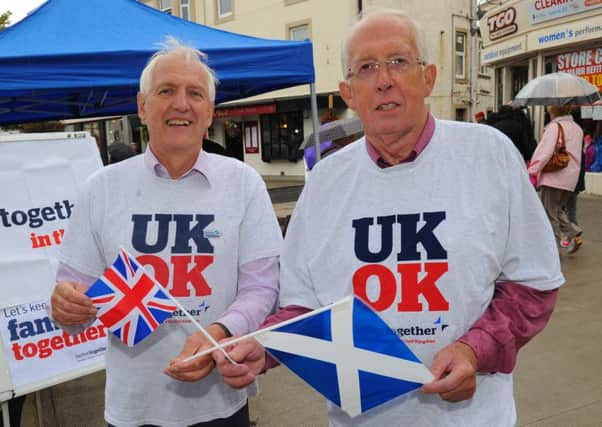Tom Peterkin: The tricky task of reprising the No campaign


The Brexit vote has triggered a rattling of indyref2 sabres which appears to grow ever louder as the UK embarks on its complex constitutional journey with an unknown destination.
While Nicola Sturgeon plays her noisy game of “Will She? Won’t She?”, her supporters are forming up behind her in a state of readiness should she choose to implement the new referendum legislation published last week.
Advertisement
Hide AdAdvertisement
Hide AdOne suspects that relaunching a Yes campaign that drew heavily on the SNP’s formidable machine could be done in the blink of an eye, while the search for a figurehead need go no further than Sturgeon herself.
But what of the other side? At the opposite end of Scotland’s constitutional divide, things are perhaps not quite as straightforward.
Speaking to individuals who were involved in the Better Together campaign over the past few days, it is possible to detect a variety of views on what needs to happen. From some there was barely concealed frustration that not enough appears is being done to counter Surgeon’s threat of a second independence referendum.
From others, including Alistair Darling, there was defiance. At the weekend Darling was adamant that Sturgeon did not want a referendum “any time soon” because she would lose. His argument was why should a campaign against Scottish independence be reconvened when the people of Scotland did not want a second referendum?
Another individual who was heavily involved with Better Together objected to the fact that Sturgeon was using the 62 per cent Scottish support for Remain in the EU referendum to threaten indyref2.
“People like me are being used as the fodder,” he said. “People who voted to Remain but have absolutely no interest in another Scottish referendum are being falsely used as the justification for demanding a second independence referendum. The campaign should be No to a referendum.”
Another view in favour of a low key approach was that taking formal steps to resurrect Better Together would only serve to “encourage” independence supporters by creating the impression it was game on.
But given that this vote could, in theory, take place before the UK leaves the EU in little over two years’ time, surely some basic due diligence should be carried out in the form of laying the groundwork for another No campaign? Although the polls suggest there is still not enough support for Sturgeon to actually win a referendum, the mood of a nation can change – particularly during such uncertain times.
Advertisement
Hide AdAdvertisement
Hide AdPerhaps the most obvious question facing those looking to protect Scotland’s place in the Union is who will do what Alistair Darling did last time?
When asked at the weekend whether he would be prepared to reprise his role as Better Together leader, the former Labour Chancellor stonewalled, saying it was not an issue because there would not be a referendum in the near future.
In any case, it is difficult to imagine that Darling would have the appetite to go through another intensely bruising campaign.
The hard truth is there is no obvious candidate to succeed Darling – a state of affairs that has led to calls for a leader from outwith politics, even though it is difficult to imagine who that might be.
Whatever happens, Darling’s experience would have to be used and there is little doubt he would be an influential, if less prominent, figure in the event of a re-run.
Ruth Davidson is often cited as a potential leader. She has proved an effective leader of the revived Scottish Tories. Despite her personal popularity, her association with the Conservatives makes it nigh impossible for her to be the key figure in a No campaign.
The demise of the Labour Party is another difficulty facing those of a No persuasion.
The notion that Labour was damaged by its partnership with the Tories in Better Together is proving hard to shake off – even if there are those who would say that Kezia Dugdale’s party was in free-fall long before the 2014 referendum. Therefore there will be a reluctance for Labour to wed itself to a campaign involving the Tories.
Advertisement
Hide AdAdvertisement
Hide AdAnother consequence of Labour’s fall from grace has been the extinction of the party’s big Scottish Westminster beasts. The likes of Douglas Alexander and Jim Murphy – key figures in Better Together – are no longer involved in front-line politics.
Not only does that reduce the field when it comes to choosing a No campaign leader, but it also closes important lines of communication.
Both Alexander and Murphy opened up informal channels with the UK government. This was done through the Lib Dem Danny Alexander, who was Chief Secretary to the Treasury in David Cameron’s coalition government. So Danny Alexander’s absence will also be keenly felt, as will the handful of other Scottish Lib Dems in the UK Government who at least were able to offer an ear which was attuned to Scottish affairs.
In Theresa May’s government, Scottish Secretary David Mundell has been left as the sole minister representing a Scottish seat.
The challenges facing a campaign to keep Scotland within a UK outside the EU are many and complex.
It might be an idea to get on with working out how they can be met – just in case Nicola Sturgeon’s sabre ceases rattling and strikes in earnest.